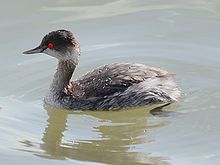This little fellow is a sparrow - perhaps a Brewer's Sparrow (Spizella breweri) or Chipping Sparrow (Spizella passerina). They appear in flocks of six to a dozen in the empty lots nearby and forage on the ground amongst the mixed grasses and bushes.
My initial reaction to spotting this solitary bird was 'a cardinal'. The birding reports mentioned spotting Northern Cardinals and Pyrrhuloxias, a name I wasn't familiar with. Sibley's pointed the way and the photo below, not as clear as I'd like, is of Cardinalis sinuatus. "Common in brushy desert habitat; moving in small groups through brushy vegetation; stubby, curved, yellowish bill and longer pointed crest" (page 398).
 |
| Pyrrhuloxia (Cardinalis sinuatus) |
This photo was taken with my cellphone, so is not distinct. This particular Snowy Egret (Egretta thula) was intent on some fish in the water between A and B dock, near the entrance ramps. SIBLEY'S states: "forages for small fish in shallow water, actively crouching and running" (page 57) - exactly what we observed.
 |
| Snowy Egret (Egretta thula) at marina |
 |
| Eared or Black-necked Grebe (Podiceps nigricollis) courtesy of Wikipedia |
 |
| Raft up of seabirds - possibly Eared Grebes - San Juanico 2012 |
Brown Pelicans (Pelecanus occidentalis) and Turkey Vultures (Cathartes aura) are common sightings as well. These photos were on San Francisco Beach on our visit to the Estero. The pelicans are a delight to watch as they plunge-dive into the water to catch their meal. I particularly love to watch them as they fly in a low formation just above the water, keeping in time, rising and falling.
 |
| Brown Pelican (Pelecanus occidentalis) |
 |
| Turkey Vulture (Cathartes aura) |
The Turkey Vulture has a "distinctive flight with wings raised in dihedral and tilting gently from side to side" (Sibley, page 96).
Always on the lookout for new sightings.
Always on the lookout for new sightings.


No comments:
Post a Comment